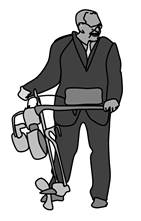Blogpost by Founder Joe Grez, November 21, 2023
As early as the mid to late 1800s, electric launches were quite popular– there was even a public boat charging network on the Themes. At the 1900 World's fair, something like 100 electric launches ferried fair–goers to and from the exhibits. But powerboating back then was an activity for the rich. It would not be until the advent of the outboard form factor that the general public was given easier access to power boating. And the very first outboard motors were electric.

There were earlier patents and examples but in 1900, the Submerged Electric Motor Company in Menomonie Wisconsin patented and sold an electric outboard, similar in concept to the familiar trolling motors sold today under the brands Minn Kota and Motorguide, Watersnake etc.
The first commercial outboard using fossil fuels was launched 6 years later by Cameron B. Waterman who re-purposed a motorcycle engine for power. This was not a commercial success but Waterman did coin the term "portable outboard motor" to describe his nearly 70 lb invention.

In 1907 Evinrude launched the first high volume production gas outboard and that's when things took off, at least for gas powered outboards. Evinrude's launch marked the end of production electric outboard development for quite a stretch. Aside from trolling motors, electric outboards remained a dormant category until the '70s when Morton Rey created his Ray Electric outboard motor.
In the early days, Morton pretty much did all the development and manufacturing himself. He cast his own aluminum parts, designed and manufactured his own electronics and so on. I had the honor of talking with him when starting PropEle Electric Boat Motors Inc. He was very generous with his time, wisdom, and his story motivated me to move forward. His motors are very efficient even when compared to many high tech outboards today. And a high percentage of his original motors are still in commercial operation. Morton has since passed on but his business is thriving in the care of his family.
Our business was started without a brand name in mind and it's called PropEle Electric Outboard Motors Inc, or PEBM for short. We started producing ultralight electric outboards in 2012 expressly to make ship to shore easier. The first product, the Electric Paddle was a very light 8 lb. and provided just enough power to propel smaller dinghies at a comfortable rowing speed. We discontinued this product in 2015 in order to re-focus our efforts on developing the EP Carry, a similar motor but with 3x the power. This new motor is suitable for practically any small craft under 13ft where portability is a main requirement. It's also a premium product designed for usability, reliability, survivability.
These days, outboards have gone all tech. But with that comes disposability. The current state of the art is to include fragile short-lived components like fragile castings, tiny clamp screws, LCD screens, GPS, pressure sensitive buttons, submerged electronics, a battery that must be attached with multiple screw-type wire connections and so-on.
EP Carry is a no-nonsense marine scale design with tinned wires, no buttons or under-water seals to fail, the motor and electronics ride high and dry in the head, it has only one robust and waterproof snap lock power connector with 2 gold plated pins/sockets. The 6 lb buoyant waterproof battery lives in a soft buoyant case on the rear seat of your boat. Our tech is locked in poured epoxy with all soldered connections also submerged in epoxy. This has proven remarkably resistant to failure from vibration and water immersion. The battery cord is replaceable as is nearly every other part or subassembly so it can be kept going through years of tough use. But EP Carry does have a wireless connection that allows you to change the programming for two different power limits. And when out app launches, it will do everything else, Today's smart phones may be disposable but the motor isn't.
With battery, motor and propeller technology improving, electric performance is now reaching a point of propulsion superiority against even fuel powered outboards for some applications. My analysis concludes that with today's batteries and EP Carry's technology, an electric can outperform a gas motor in terms of weight, propulsive power and range up to an equivalent 6 hp size. For electric to out-perform gas in larger sizes, it requires higher density battery tech than is available right now.
Ray electric produces probably the most reliable and robust electric outboard for commercial applications like tour boats. Torqeedo produces high tech outboards for boats 1500 lb and up. Elco offers lower propulsion efficiency electric outboards based on gasoline motor platforms starting at 10 hp, and Pure Watercraft produces the motor of choice for crew race coach boats. There is a new batch of pre-launch high power options developing that are targeting 50 hpe to over 100 hpe.
But of all these brands, EP Carry is the only outboard optimized for small boats under 13 ft and 600 lb. This creates a propulsive effect 3x – 5x more efficient than a trolling motor, and 2x more efficient than other high tech pod electrics. Because of this efficiency edge, the award winning EP Carry weighs just 20 lb, 14 lb less than any other integrated outboard making it the best choice for small boats.